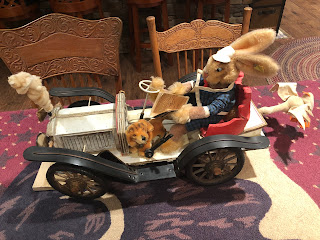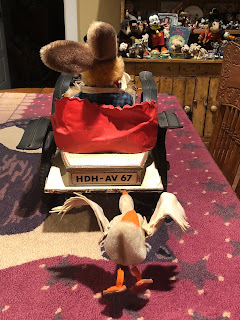Here we have Steiff's Max doll. He is 30 cm tall, fully jointed, and made primarily from felt. He wears grey felt shoes, cream felt pants, a brown felt shirt, and a blue felt blazer detailed with blue felt buttons. His legs are made from tan linen. His oversized hands and head are made from flesh colored felt. His face comes to life with black bead eyes, prominent horizontal and vertical seaming, painted eyebrows and lips, and pert, oversized ears. You can't help but notice his shock of long, jet black hair which is made from mohair. You can see two slits in his left ear where his Steiff button would have been, but sadly this hardware has been lost to time. Max appeared in the Steiff line in 30 and 35 cm from 1910-1926.
Steiff has a century plus long tradition of interpreting famous fictional and literary characters... and this doll is a perfect example of that. Max - and his brother Moritz - are the "stars" of a legacy German book called Max and Moritz (A Story of 7 Boyish Pranks). It was written by author Wilhelm Busch (German, 1832-1908). This work was first published in 1865. This darkly comedic tale is written in verse and consists of seven “chapters.” Max and Moritz are the ultimate troublemakers and they cast their shenanigans throughout their town. The book, still a favorite nearly 160 years onward, has become an integral part of the German culture and psyche. Author Rudolph Dirks credits Max and Moritz as the inspiration behind his early and important comic strip The Katzenjammer Kids which debuted in 1897. And even today, some German parents are known to have named their twin sons after this troublemaking team.
Given his appeal, Max (and his brother) were often featured in Steiff's early 20th century advertising. Here on the left, you can see one of Steiff's print marketing images from around 1912/13. You can click on the image to make it bigger. It features the silly siblings creating havoc at a military post. This is not unexpected, given their reputation for troublemaking! Max has made his way into the soldier's booth - and appears to be picking his nose without a care. And his brother Moritz has somehow gotten his hands on the soldier's firearm and is running away with it. Steiff's marketing images from this period - just like this one - are usually comical, multilayered, ironic, and extremely well executed. The picture is from Dottie Ayers and Donna Harrison's Advertising Art of Steiff, Teddy Bears and Playthings.
It should be no surprise that Steiff really "Max'ed" out on its Max doll production during both the pre- and postwar periods. Prewar, Max and Moritz were produced as 25 cm “record” or pull toy dolls on wooden wheels from 1916-1926 overall. Fast forward, Steiff produced Max and Moritz as tiny 10 cm rubber dolls from 1962-1967. Their final appearance in Steiff's catalog, as far as Steiffgal can tell, was as a pair of 30 cm tall trevira velvet puppets pictured here on the left. These charming characters appeared in the line from 1979-1982. As you can see, their detailing, materials, and construction were updated to reflect the aesthetic of the era.
Steiffgal hopes this discussion on Steiff's Max storybook doll has been a good read for you.
Have a question about one of your Steiff treasures? Let's talk! Click here to learn more.















